Role of Al in the Solution Strengthening of Mg–Al Binary Alloys
Abstract
:1. Introduction
2. Materials and Methods
3. Results and Discussion
4. Conclusions
- Microstructure of as-extruded Mg–Al alloys has been refined and the average grain size is related to the concentration of aluminum within certain limits. Moreover, the texture of as-extruded Mg–Al alloys is in a similar situation as well.
- For Mg–xAl (x = 1, 2, 3, 4) alloys, yield strength increases from 142 MPa to 160 MPa, and ultimate tensile strength rises from 225 MPa to 251 MPa. And the fracture elongation of Mg–3Al reaches the maximum of 21.3% among four Mg–Al alloys.
- The results of VPSC simulation match well with the experimental data. The simulation results show that basal slip plays a decisive part in deformation mechanism in Mg alloys.
5. Patents
Author Contributions
Funding
Acknowledgments
Conflicts of Interest
References
- Alanem, K.K.; Okotete, E.A. Enhancing plastic deformability of Mg and its alloys—A review of traditional and nascent developments. J. Magnes. Alloy. 2017, 5, 460–475. [Google Scholar] [CrossRef]
- Song, J.F.; She, J.; Chen, D.L.; Pan, F.S. Latest research advances on magnesium and magnesium alloys worldwide. J. Magnes. Alloy. 2020, 8, 1–41. [Google Scholar] [CrossRef]
- Gu, D.D.; Peng, J.; Wang, J.W.; Liu, Z.T.; Pan, F.S. Effect of Mn Modification on the Corrosion Susceptibility of Mg–Mn Alloys by Magnesium Scrap. Acta Metall. Sinica 2021, 34, 1–11. [Google Scholar] [CrossRef]
- Liao, H.B.; Zhan, M.Y.; Li, C.B.; Ma, Z.Q.; Du, J. Grain refinement of Mg–Al alloys inoculated by MgAl2O4 powder. J. Magnes. Alloy. 2021, 9, 1211–1219. [Google Scholar] [CrossRef]
- Mordike, B.L.; Ebert, T. Thermal conductivity of as-cast and as-extruded binary Mg–Al alloys. J. Alloy. Compd. 2014, 608, 19–24. [Google Scholar]
- Wang, C.L.; Dai, J.C.; Liu, W.C.; Zhang, L.; Wu, G.H. Effect of Al additions on grain refinement and mechanical properties of Mg-Sm alloys. J. Alloy. Compd. 2015, 620, 172–179. [Google Scholar] [CrossRef]
- Jiang, Z.T.; Jiang, B.; Yang, H.; Yang, Q.S.; Dai, J.H.; Pan, F.S. Influence of the Al2Ca phase on microstructure and mechanical properties of Mg–Al–Ca alloys. J. Alloy. Compd. 2015, 647, 357–363. [Google Scholar] [CrossRef]
- Ma, X.L.; Jiao, Q.; Kecskes, J.L.; El-Awady, J.A.; Weihs, T.P. Effect of basal precipitates on extension twinning and pyramidal slip: A micro-mechanical and electron microscopy study of a Mg–Al binary alloy. Acta Mater. 2020, 189, 35–46. [Google Scholar] [CrossRef]
- Zha, M.; Zhang, H.M.; Wang, C.; Wang, H.Y.; Zhang, E.B.; Jiang, Q.C. Prominent role of a high volume fraction of Mg17Al12 particles on tensile behaviors of rolled Mg–Al–Zn alloys. J. Alloy. Compd. 2017, 728, 682–693. [Google Scholar] [CrossRef]
- Li, Y.K.; Zha, M.; Jia, H.L.; Wang, S.Q.; Zhang, H.M.; Ma, X.; Tian, T.; Ma, P.K.; Wang, H.Y. Tailoring bimodal grain structure of Mg–9Al–1Zn alloy for strength-ductility synergy: Co-regulating effect from coarse Al2Y and submicron Mg17Al12 particles. J. Magnes. Alloy. 2021, 9, 1556–1566. [Google Scholar] [CrossRef]
- Shi, G.L.; Zhang, K.; Li, X.G.; Li, Y.J.; Ma, M.L.; Yuan, J.W.; Zhang, H.J. Dislocation configuration evolution during extension twinning and its influence on precipitation behavior in AZ80 wrought magnesium alloy. J. Magnes. Alloy. 2021. [Google Scholar] [CrossRef]
- Shi, R.H.; Miao, J.S.; Luo, A.A. A new magnesium sheet alloy and its multi-stage homogenization for simultaneously improved ductility and strength at room temperature. Scr. Mater. 2019, 171, 92–97. [Google Scholar] [CrossRef]
- Tolouie, E.; Jamaati, R. Effect of β–Mg17Al12 phase on microstructure, texture and mechanical properties of AZ91 alloy processed by asymmetric hot rolling. Mat. Sci. Eng. A 2018, 738, 81–89. [Google Scholar] [CrossRef]
- Shi, R.H. Nonisothermal dissolution kinetics on Mg17Al12 intermetallic in Mg–Al alloys. J. Magnes. Alloy. 2021. [Google Scholar] [CrossRef]
- She, J.; Pan, F.; Zhang, J.; Tang, A.; Luo, S.; Yu, Z.; Song, K.; Rashad, M. Microstructure and mechanical properties of Mg–Al–Sn extruded alloys. J. Alloy. Compd. 2016, 657, 893–905. [Google Scholar] [CrossRef]
- Liu, T.T.; Yang, Q.S.; Guo, N.; Lu, Y.; Song, B. Stability of twins in Mg alloys—A short review. J. Magnes. Alloy. 2020, 8, 66–77. [Google Scholar] [CrossRef]
- Guo, F.L.; Feng, B.; Fu, S.W.; Xin, Y.C.; Xu, S.W.; Liu, Q. Microstructure and texture in an extruded Mg–Al–Ca–Mn flat-oval tube. J. Magnes. Alloy. 2017, 5, 13–19. [Google Scholar] [CrossRef]
- Zhou, B.J.; Wang, L.Y.; Wang, J.H.; Maldar, A.; Zhu, G.M.; Jia, H.L.; Jin, P.P.; Zeng, X.Q.; Li, Y.J. Dislocation behavior in a polycrystalline Mg-Y alloy using multi-scale characterization and VPSC simulation. J. Mater. Sci. Technol. 2022, 98, 87–98. [Google Scholar] [CrossRef]
- Zhao, L.Y.; Chapuis, A.; Xin, Y.C.; Liu, Q. VPSC-TDT modeling and texture characterization of the deformation of a Mg–3Al–1Zn plate. J. Alloy. Compd. 2017, 710, 159–165. [Google Scholar] [CrossRef]
- Tam, K.J.; Vaughan, W.M.; Shen, L.M.; Knezevic, M.; Karaman, I.; Proust, G. Modelling the temperature and texture effects on the deformation mechanisms of magnesium alloy AZ31. Int. J. Mech. Sci. 2020, 182, 105717. [Google Scholar] [CrossRef]
- Molinari, A.; Canova, G.R.; Ahzi, S. A Self-Consistent Approach of the Large Deformation Polycrystal Viscoplasticity. Acta Metall. Mater. 1987, 35, 2983–2994. [Google Scholar] [CrossRef]
- Lebensohn, R.A.; Tome, C.N. A Self-Consistent Viscoplastic Model—Prediction of Rolling Textures of Anisotropic Polycrystals. Mat. Sci. Eng. A 1994, 175, 71–82. [Google Scholar] [CrossRef] [Green Version]
- Lebensohn, R.A.; Tome, C.N.; Maudlin, P.J. A selfconsistent formulation for the prediction of the anisotropic behavior of viscoplastic polycrystals with voids. J. Mech. Phys. Solids 2004, 52, 249–278. [Google Scholar] [CrossRef]
- Maldar, A.; Wang, L.Y.; Zhu, G.M.; Zeng, X.Q. Investigation of the alloying effect on deformation behavior in Mg by Visco-Plastic Self-Consistent modeling. J. Magnes. Alloy. 2020, 8, 210–218. [Google Scholar] [CrossRef]
- Zhang, Y.; Huang, X.; Ma, Z.; Li, Y.; Guo, F.; Yang, J.; Ma, Y.; Hao, Y. The influences of Al content on the microstructure and mechanical properties of as-cast Mg-6Zn magnesium alloys. Mat. Sci. Eng. A 2017, 686, 93–101. [Google Scholar] [CrossRef]
- Zecevic, M.; Knezevic, M.; McWilliams, B.; Lebensohn, R.A. Modeling of the thermo-mechanical response and texture evolution of WE43 Mg alloy in the dynamic recrystallization regime using a viscoplastic self-consistent formulation. Int. J. Plasticity 2020, 130, 102705. [Google Scholar] [CrossRef]
- Tomasz, C.; Wojciech, Z.; Elżbieta, B. Study of the thermal stability of phases in the Mg-Al system. J. Phase Equilib. 2003, 24, 249–254. [Google Scholar]
- Li, M.; Cheng, Y.; Zheng, Y.F.; Zhang, X.; Xi, T.F.; Wei, S.C. Plasma enhanced chemical vapor deposited silicon coatings on Mg alloy for biomedical application. Surf. Coat. Technol. 2013, 228, S262–S265. [Google Scholar] [CrossRef]
- Yu, L.; Yan, H.G.; Chen, J.H.; Xia, W.J.; Su, B.; Song, M. Effects of solid solution elements on damping capacities of binary magnesium alloys. Mat. Sci. Eng. A 2020, 772, 138707. [Google Scholar] [CrossRef]
- Zhou, S.; He, X.; Peng, P.; Liu, T.; Sheng, G.; Tang, A.; Pan, F. Achieving high yield strength and ductility in as-extruded Mg–0.5Sr alloy by high Mn-alloying. Materials 2020, 13, 4176. [Google Scholar] [CrossRef]
- Zhao, J.; Jiang, B.; Yuan, Y.; Tang, A.T.; Sheng, H.R.; Yang, T.H.; Huang, G.S.; Zhang, D.F.; Pan, F.S. Influence of Zn addition on the microstructure, tensile properties and work-hardening behavior of Mg–1Gd alloy. Mat. Sci. Eng. A 2020, 772, 138779. [Google Scholar] [CrossRef]
- She, J.; Zhou, S.B.; Peng, P.; Tang, A.T.; Wang, Y.; Pan, H.C.; Yang, C.L.; Pan, F.S. Improvement of strength-ductility balance by Mn addition in Mg–Ca extruded alloy. Mat. Sci. Eng. A 2020, 772, 138796. [Google Scholar] [CrossRef]
- Zheng, X.; Du, W.; Liu, K.; Wang, Z.; Li, S. Effect of trace addition of al on microstructure, texture and tensile ductility of Mg–6Zn–0.5Er alloy. J. Magnes. Alloy. 2016, 4, 135–139. [Google Scholar] [CrossRef] [Green Version]
- Yu, H.; Li, C.; Xin, Y.; Chapuis, A.; Huang, X.; Liu, Q. The mechanism for the high dependence of the Hall-Petch slope for twinning/slip on texture in Mg alloys. Acta Mater. 2017, 128, 313–326. [Google Scholar] [CrossRef]
- Bakarian, P.W. Glide and Twinning in Magnesium Single Crystals at Elevated Temperatures; Yale University: New Haven, CT, USA, 1941. [Google Scholar]
- Akhtar, A.; Teghtsoonian, E.J.A.M. Solid solution strengthening of magnesium single crystals—ii the effect of solute on the ease of prismatic slip. Acta Metall. 1969, 17, 1351–1356. [Google Scholar] [CrossRef]

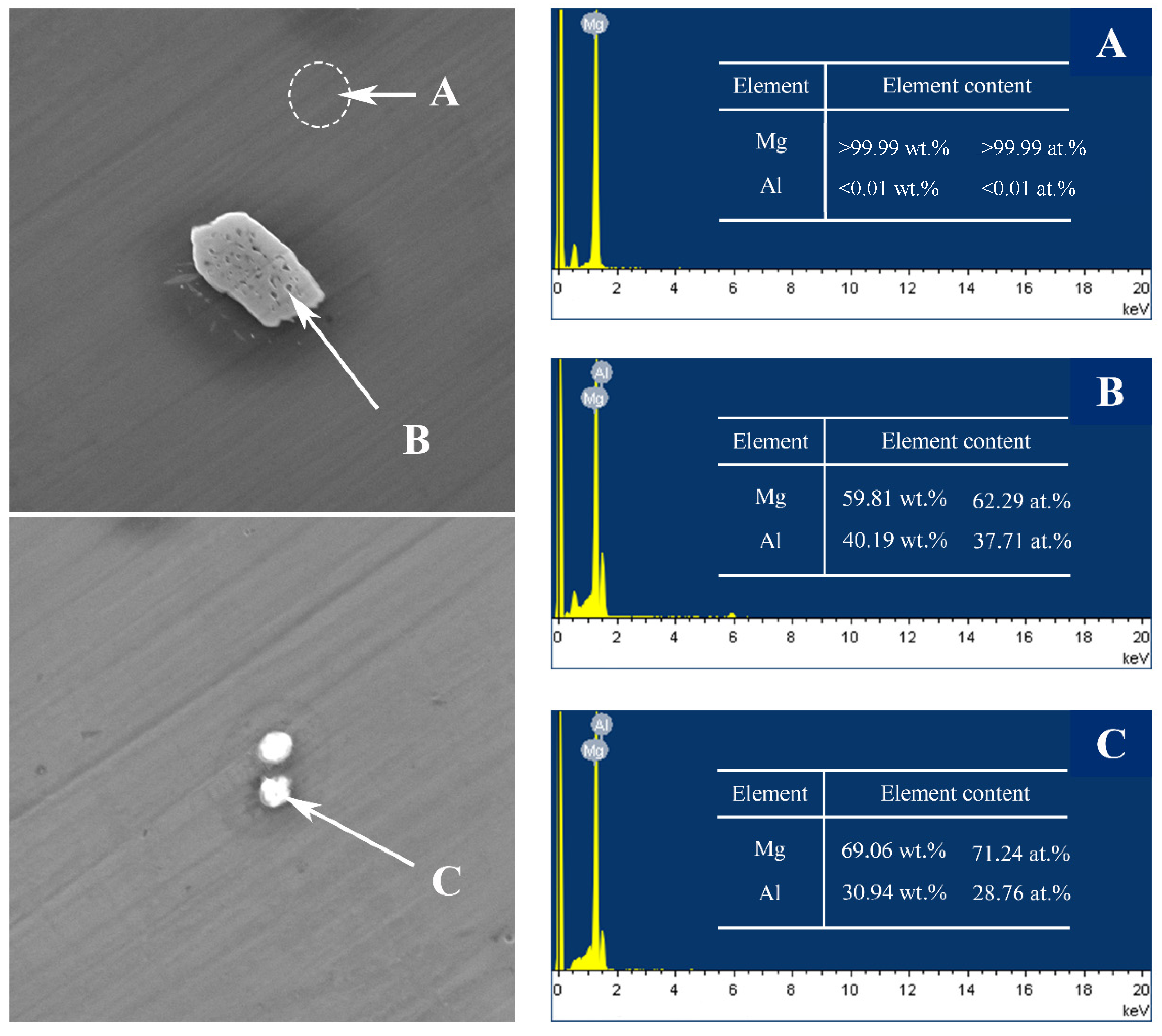


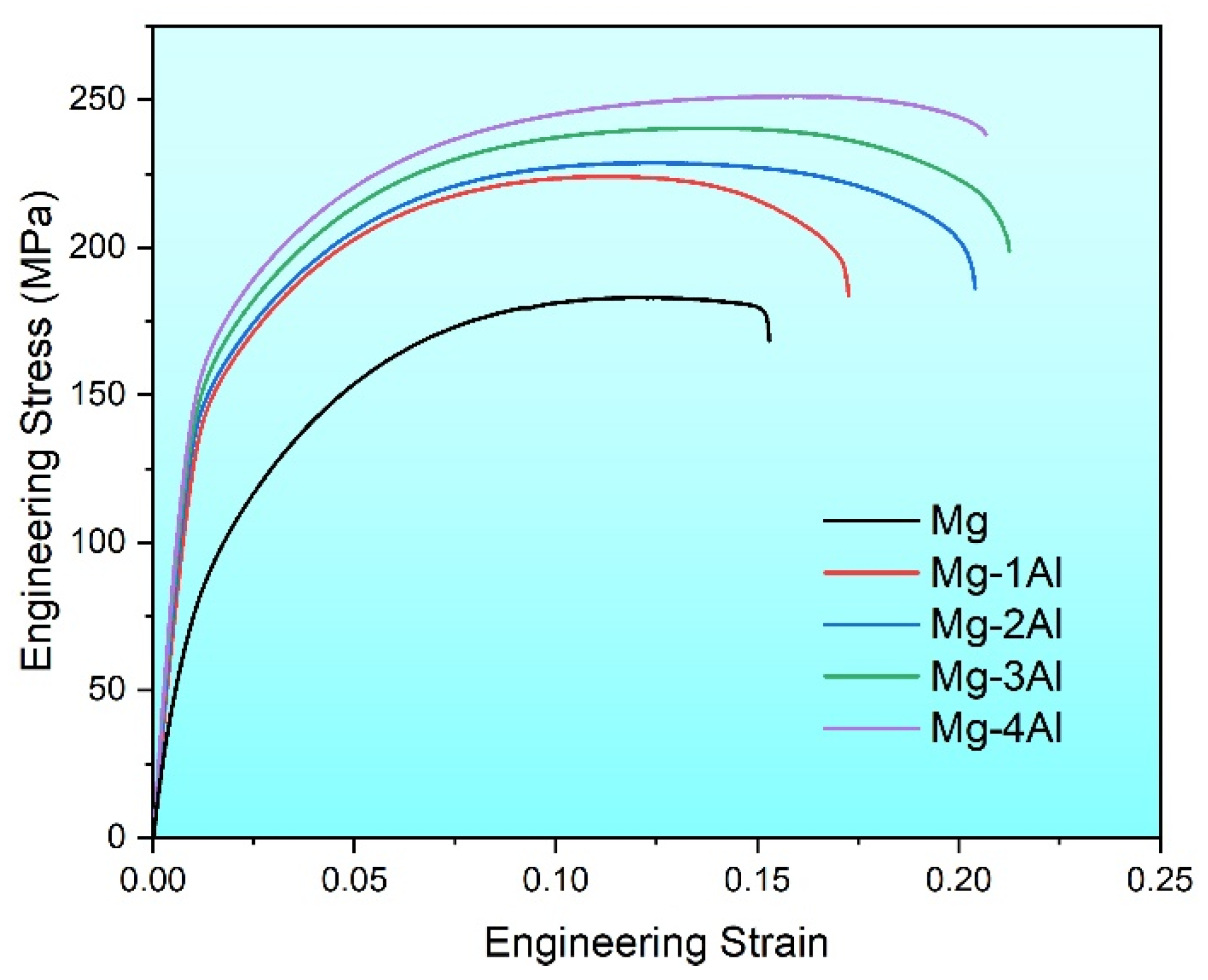
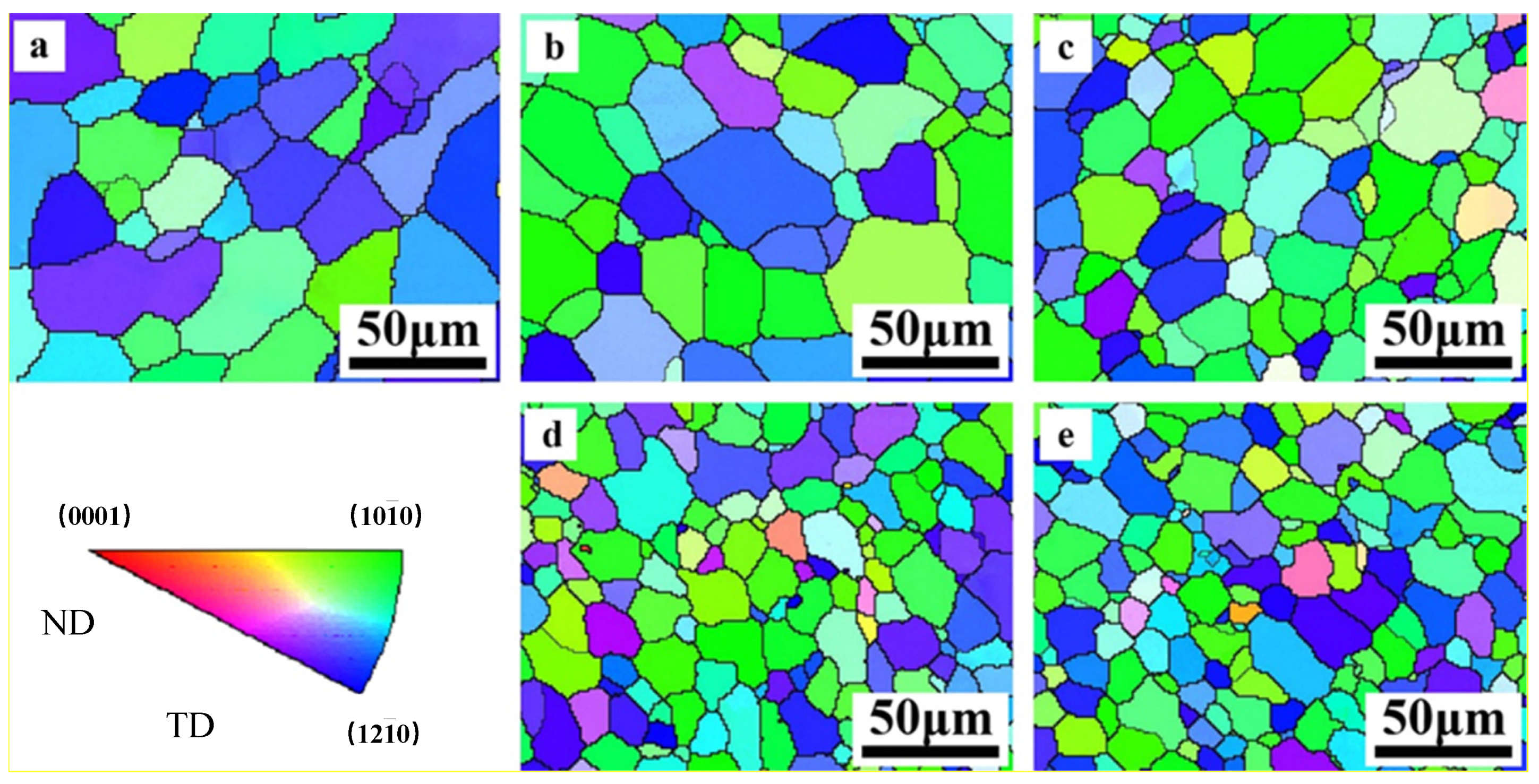
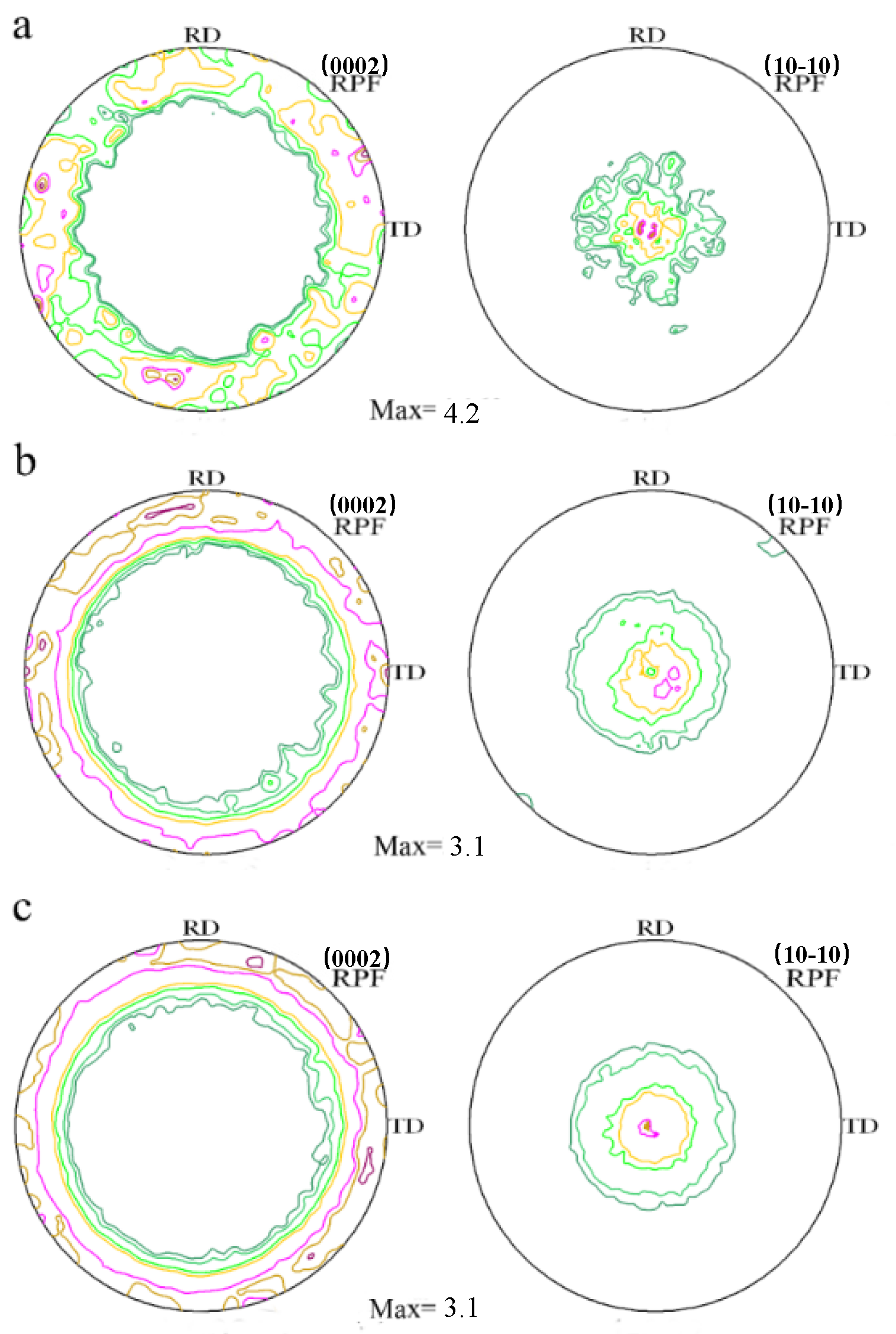
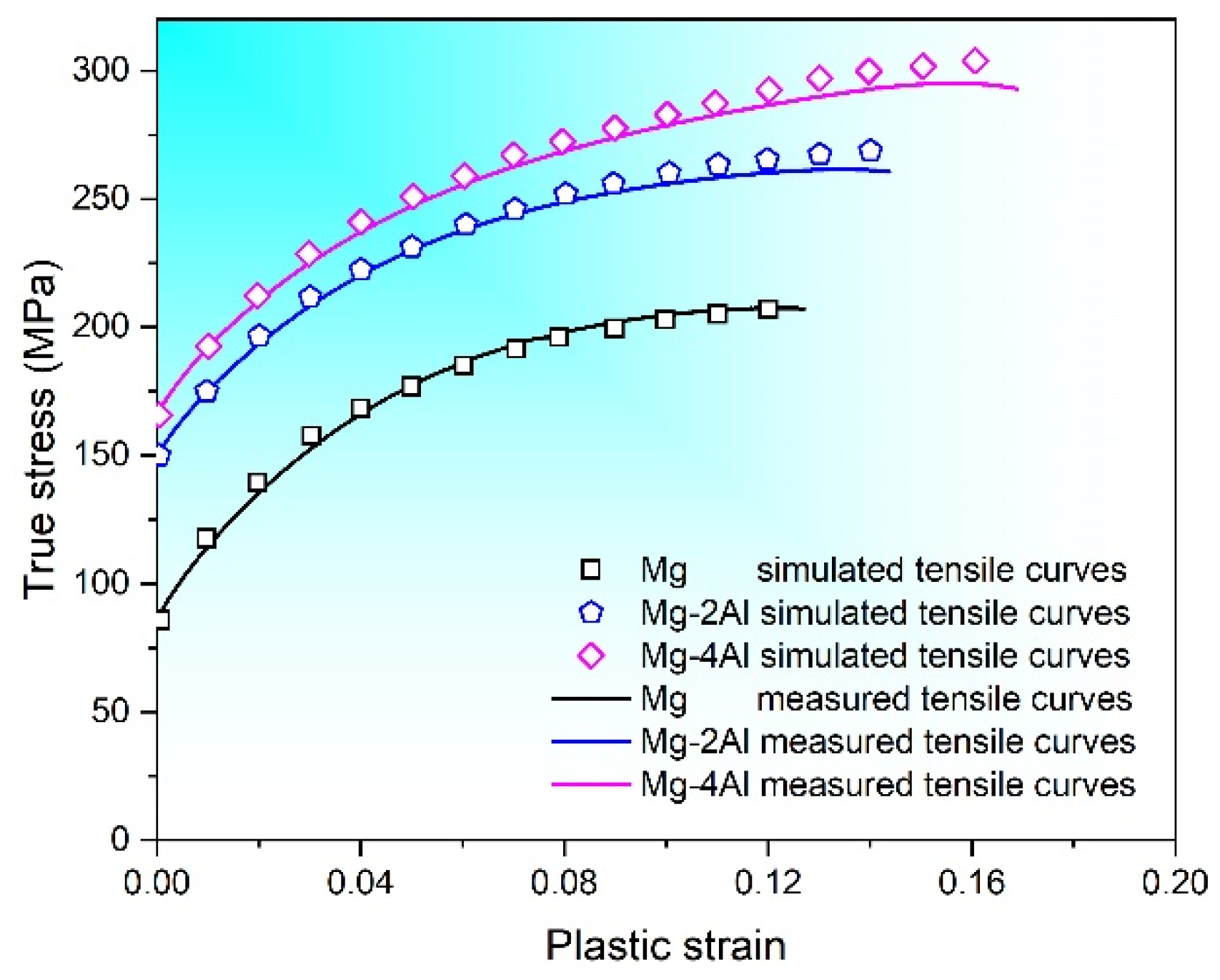

| Alloys | Compositions (wt.%) | TYS (MPa) | UTS (MPa) | FE (%) |
|---|---|---|---|---|
| Mg | Mg | 75 ± 0.5 | 182 ± 0.8 | 15.1 ± 0.2 |
| Mg–1Al | Mg–1.06Al | 142 ± 1.7 | 225 ± 1.2 | 17.1 ± 0.6 |
| Mg–2Al | Mg–1.99Al | 151 ± 0.9 | 230 ± 0.9 | 20.4 ± 0.8 |
| Mg–3Al | Mg–3.07Al | 156 ± 0.8 | 240 ± 0.5 | 21.3 ± 0.9 |
| Mg–4Al | Mg–3.96Al | 160 ± 1.2 | 251 ± 0.8 | 20.8 ± 0.9 |
| Specimens | Mode | τ0/MPa | τ1/MPa | θ0/MPa | θ1/MPa |
|---|---|---|---|---|---|
| Mg | Basal | 5 | 30 | 800 | 30 |
| Prismatic | 150 | 10 | 1200 | 0 | |
| Pyramidal <a> | 245 | 10 | 300 | 0 | |
| Pyramidal <c + a> | 185 | 10 | 100 | 0 | |
| Extension twin | 80 | 100 | 2500 | 0 | |
| Contraction twin | 275 | 300 | 1500 | 0 | |
| Mg–2Al | Basal | 18 | 30 | 1000 | 70 |
| Prismatic | 180 | 10 | 1200 | 0 | |
| Pyramidal <a> | 245 | 65 | 300 | 0 | |
| Pyramidal <c + a> | 205 | 70 | 100 | 0 | |
| Extension twin | 75 | 170 | 2500 | 0 | |
| Contraction twin | 275 | 300 | 1500 | 0 | |
| Mg–4Al | Basal | 22 | 30 | 1000 | 80 |
| Prismatic | 200 | 10 | 1200 | 0 | |
| Pyramidal <a> | 245 | 65 | 300 | 0 | |
| Pyramidal <c + a> | 225 | 70 | 100 | 0 | |
| Extension twin | 70 | 170 | 2500 | 0 | |
| Contraction twin | 275 | 300 | 1500 | 0 |
Publisher’s Note: MDPI stays neutral with regard to jurisdictional claims in published maps and institutional affiliations. |
© 2022 by the authors. Licensee MDPI, Basel, Switzerland. This article is an open access article distributed under the terms and conditions of the Creative Commons Attribution (CC BY) license (https://creativecommons.org/licenses/by/4.0/).
Share and Cite
Liu, T.; Liu, Y.; Xiao, L.; Zhou, S.; Song, B. Role of Al in the Solution Strengthening of Mg–Al Binary Alloys. Metals 2022, 12, 84. https://doi.org/10.3390/met12010084
Liu T, Liu Y, Xiao L, Zhou S, Song B. Role of Al in the Solution Strengthening of Mg–Al Binary Alloys. Metals. 2022; 12(1):84. https://doi.org/10.3390/met12010084
Chicago/Turabian StyleLiu, Tingting, Yanglu Liu, Lu Xiao, Shibo Zhou, and Bo Song. 2022. "Role of Al in the Solution Strengthening of Mg–Al Binary Alloys" Metals 12, no. 1: 84. https://doi.org/10.3390/met12010084






